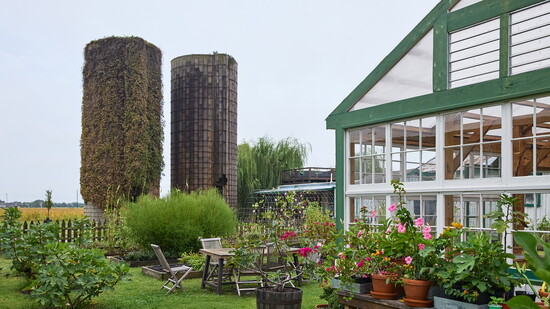Just across the Mississippi River in Arkansas, Mound City blends historical significance with modern charm as a farm, event space and vacation destination. Both the Trail of Tears and the Esperanza Trail pass through the property, designating it as a historical landmark. The settlement was named for the nine ceremonial Native American mounds built by the Pacaha Indians of the Mississippian Culture. Most of the mounds were leveled for farming in the early 1900s, though one remains and now houses Mound City’s Commissary. During and after the Civil War, Mound City thrived as a river town until the Mississippi River shifted course, diminishing its importance but preserving its fertile farmland.
Mound City operated as a working farm for many years, finding new life in 2012 when Charlie and Emily Lowrance purchased the property. Growing up in Driver, Arkansas, Charlie often detoured through Mound City on his way to Memphis while dating Emily. “I was always drawn to Mound City,” he recalls. “So when the opportunity arose to buy it – I did!” What began as an investment in a working farm quickly revealed the charm and potential for something more.
The farm included four old tenant, or sharecropper, houses that needed either demolition or renovation. Inspired by what his friend Guy Malvezzi had accomplished with the Shack Up Inn in Clarksdale, Charlie decided to restore them one at a time. “Guy told me to just start,” he remembers. “See how it’s going, and if they rent well and you’re still enjoying it, do another one.” The first two houses proved successful—one listed on Airbnb, the other rented as office space to a realtor—encouraging the Lowrances to keep going.
Their efforts soon expanded to the remaining houses and eventually to the Commissary. On empty lots where homes had once stood, they built new farmhouses in the old style, so authentic that guests often cannot tell which buildings are original and which are new. “In all, it took about five years to complete the building projects on the farm,” Emily shares. Along the way, visitors sometimes lent a hand.
During COVID, several large Amish families stayed at Mound City while their children received treatment at St. Jude. Too large to qualify for the Ronald McDonald or Target Houses, these families found both lodging and purpose by helping with farm projects. Together, they built fences, repaired an old car, assisted with the greenhouse construction and even restored and installed a 300-pound antique bell from Charlie’s family farm in Driver. Remarkably, they completed this work without modern machinery, relying instead on traditional hand tools. Charlie and Emily describe their craftsmanship with awe.
Over time, the farm’s community grew in other ways as well. John and Jasmine Hoover, now property managers at Mound City, first arrived as guests from California. Captivated by the charm of the farm, they stayed in touch with Charlie and Emily. Two or three years later, when the couple began exploring a move to the South, they reached out for advice. Instead of sending them elsewhere, the Lowrances invited them to live on-site and manage the property. Today, John and Jasmine oversee daily operations, helping Mound City continue its legacy of hospitality.
As the farm grew, so did its role as a gathering place. What began as a few overnight rentals naturally evolved into a broader hospitality business. Mound City now welcomes weddings, family reunions, corporate meetings, Boy Scout campouts and other celebrations. “It was not intentional to rent Mound City as an event space,” Emily notes. “That was just the natural evolution of the project.”
Still, Charlie’s true passion may lie in his vineyard. After finishing the building projects, he wanted to plant something special in the field beside the Commissary. Although Arkansas is not known as wine country, he researched grapes that could thrive in the hot, humid Delta climate. He eventually planted Le Nor, Chambourcin, Blanc du Bois and Muscadine varieties. For Charlie, the work blends farming and creativity, a chance to grow something enduring and shareable.
At the end of the growing season, Charlie and Emily host a grape-stomping party where friends gather to celebrate the harvest. Guests kick off their shoes to crush grapes with their bare feet. Afterwards, Charlie ferments, ages and bottles the wine himself—a labor that, like the farm’s restoration, is rooted in both tradition and passion.
Mound City today stands as a rare combination of history and hospitality. What began as a working farm has grown into a place where the past is honored, and visitors are welcomed like family. From its Native American mounds and Civil War legacy to restored farmhouses and flourishing vineyards, Charlie and Emily Lowrance have created a destination that is both meaningful and memorable. Whether guests come to celebrate milestones, explore historic trails or simply sip wine at sunset, Mound City offers an experience that connects people to the land and to each other.
To check out Mound City for yourself, go to visitmoundcity.com.
Beside the historic Commissary, Charlie Lowrance planted a vineyard featuring Le Nor, Chambourcin, Blanc du Bois and Muscadine grapes—varieties suited to Arkansas’s humid Delta climate. Each fall, friends join in a festive grape-stomping celebration before Charlie bottles the wine himself, blending his love of farming and fellowship.
It was not intentional to rent Mound City as an event space. That was just the natural evolution of the project.
